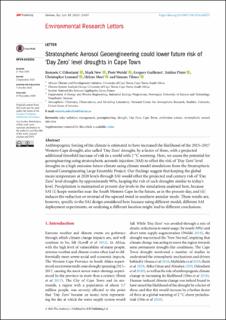| dc.contributor.author | Odoulami, Romaric C. | |
| dc.contributor.author | New, Mark | |
| dc.contributor.author | Wolski, Piotr | |
| dc.contributor.author | Guillemet, Gregory | |
| dc.contributor.author | Pinto, Izidine | |
| dc.contributor.author | Lennard, Christopher | |
| dc.contributor.author | Muri, Helene | |
| dc.contributor.author | Tilmes, Simone | |
| dc.date.accessioned | 2020-11-24T08:41:31Z | |
| dc.date.available | 2020-11-24T08:41:31Z | |
| dc.date.created | 2020-11-23T12:31:11Z | |
| dc.date.issued | 2020 | |
| dc.identifier.citation | Environmental Research Letters. 2020, 15 (12), 124007-?. | en_US |
| dc.identifier.issn | 1748-9326 | |
| dc.identifier.uri | https://hdl.handle.net/11250/2689221 | |
| dc.description.abstract | Anthropogenic forcing of the climate is estimated to have increased the likelihood of the 2015–2017 Western Cape drought, also called 'Day Zero' drought, by a factor of three, with a projected additional threefold increase of risk in a world with 2 °C warming. Here, we assess the potential for geoengineering using stratospheric aerosols injection (SAI) to offset the risk of 'Day Zero' level droughts in a high emission future climate using climate model simulations from the Stratospheric Aerosol Geoengineering Large Ensemble Project. Our findings suggest that keeping the global mean temperature at 2020 levels through SAI would offset the projected end century risk of 'Day Zero' level droughts by approximately 90%, keeping the risk of such droughts similar to today's level. Precipitation is maintained at present-day levels in the simulations analysed here, because SAI (i) keeps westerlies near the South Western Cape in the future, as in the present-day, and (ii) induces the reduction or reversal of the upward trend in southern annular mode. These results are, however, specific to the SAI design considered here because using different model, different SAI deployment experiments, or analysing a different location might lead to different conclusions. | en_US |
| dc.language.iso | eng | en_US |
| dc.publisher | Institute of Physics, IOP Science | en_US |
| dc.relation.uri | https://iopscience.iop.org/article/10.1088/1748-9326/abbf13 | |
| dc.rights | Navngivelse 4.0 Internasjonal | * |
| dc.rights.uri | http://creativecommons.org/licenses/by/4.0/deed.no | * |
| dc.subject | Climate change | en_US |
| dc.subject | Klimaendringer | en_US |
| dc.subject | Tørke | en_US |
| dc.subject | Drought | en_US |
| dc.subject | Klimamodeller | en_US |
| dc.subject | Climate models | en_US |
| dc.title | Stratospheric Aerosol Geoengineering could lower future risk of 'Day Zero' level droughts in Cape Town | en_US |
| dc.type | Peer reviewed | en_US |
| dc.type | Journal article | en_US |
| dc.description.version | publishedVersion | en_US |
| dc.subject.nsi | VDP::Meteorologi: 453 | en_US |
| dc.subject.nsi | VDP::Meteorology: 453 | en_US |
| dc.source.pagenumber | 124007-? | en_US |
| dc.source.volume | 15 | en_US |
| dc.source.journal | Environmental Research Letters | en_US |
| dc.source.issue | 12 | en_US |
| dc.identifier.doi | 10.1088/1748-9326/abbf13 | |
| dc.identifier.cristin | 1851004 | |
| dc.description.localcode | Original content from this work may be used under the terms of the Creative Commons Attribution 4.0 license. Any further distribution of this work must maintain attribution to the author(s) and the title of the work, journal citation and DOI. | en_US |
| cristin.ispublished | true | |
| cristin.fulltext | original | |
| cristin.qualitycode | 2 | |

